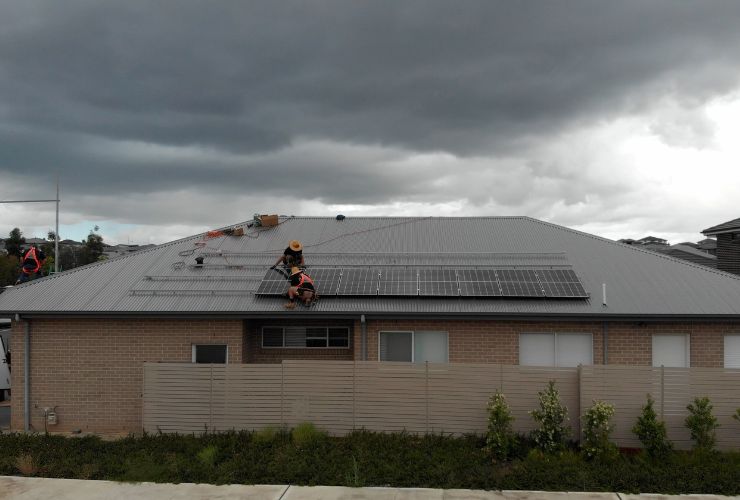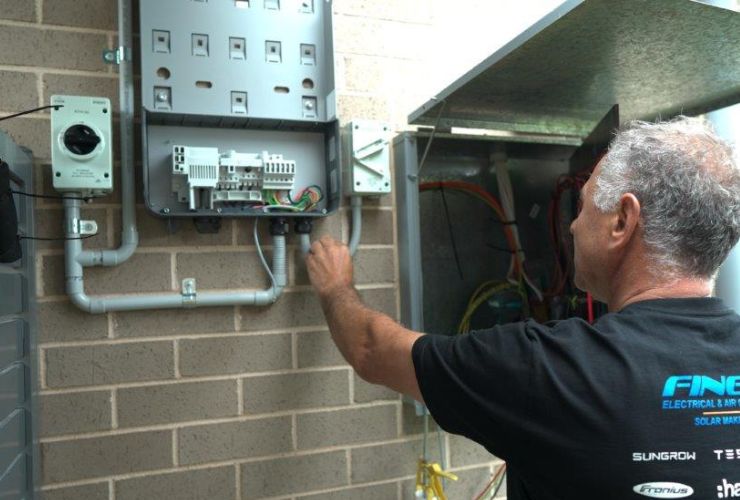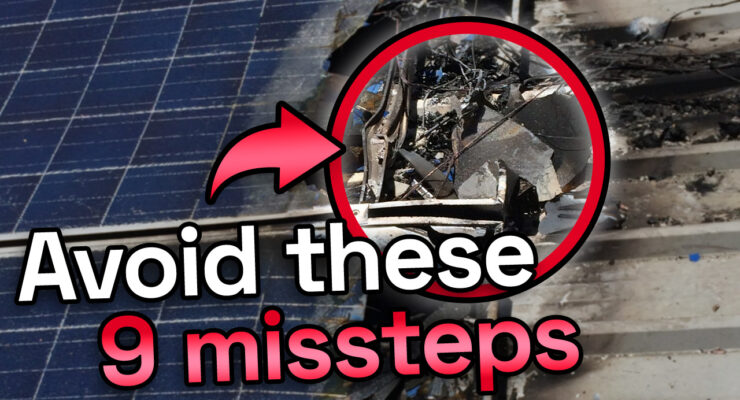Fast read
It's crucial to avoid typical errors that might lead to subpar results. As well as monetary losses regarding solar and home storage batteries.
These errors include assuming that all solar is created equal, failing to thoroughly investigate the solar company, selecting low-quality parts, disregarding where panels and inverters should be installed, relying on insufficient warranties, waiting for prices to decrease, receiving too few or too many quotes, deciding on pressure from the salesperson, and believing that a solar and battery combination is out of your price range.
By avoiding these mistakes, you may save money, lessen your carbon footprint, and increase your energy independence.
Do not make these nine rooky mistakes when it comes to solar & batteries
We lately regularly hear that electricity prices will increase by 15, 20, or even 35%. The cost of living pressure is unprecedented. If you’re looking into solar power, home batteries, or electric vehicles, this information is for you.
I have worked in the solar industry since 2006, leading sales teams for top companies in the field. Unfortunately, I have seen the same missteps made by customers repeatedly. Resulting in less-than-ideal outcomes and sometimes even a downright loss of money.
Avoiding these nine mistakes can save money, help the environment, and make you more energy-independent in ten years. You can download this misstep info as a guide from the Your Energy website. They are:
1 – Thinking all solar is the same
2 – Not checking out the solar company properly
3 – Choosing poor-quality components
4 – I do not care where the panels and inverter go
5 – Relying on useless warranties
6 – Waiting for prices to drop
7 – Getting not enough or too many quotes and getting confused
8 – Buying under sales pressure
9 – Thinking a solar/battery combination is out of your price bracket and going for a solar solution only

Mistake 1: Thinking all solar is the same
While from the street, the panels look similar, and the inverter boxes seem the same. Solar systems vary in technology, equipment, and installation quality.
All three of these aspects affect the longevity of a solar system. Solar returns money each year. Therefore the longer the system lasts, the better your income stream and CO2 offsetting ability.
For example, if one system is $2000 more expensive but will last five years longer, and if your annual benefits are $1800 in solar savings, then going for the more expensive system will put $7000 more in your pocket.
The very cheap solar systems advertised on Facebook or via cold calls consist of rubbish components, made to look like decent gear, and being installed by what is in the industry known as “roof monkeys”, which are unqualified workers who will then later have a qualified person sign off on the job.
Such solar systems always have issues, from cracked tiles to non-compliant cable runs, skimping on the number of clamps used to fasten the system to the roof, poor quality equipment choices, and many more.
Also, the after-sales service level of these mass-produced – great in marketing – poor in execution solar sales companies is non-existent.
Some of the largest operators in Australia, unfortunately, fall into this category. They close the company every few years and restart, leaving all their warranties and past customers behind.
Mistake 2: Not checking out the solar installation company properly
One can pick great equipment, although if poorly installed, the outcome will still not be satisfying. For example, even the best inverter on the market will not survive as long as possible if installed on a Northern wall, baking away in the summer. Some customers research, find out the excellent gear, and then pick the cheapest installer to do the job.
Ideally, your installation company is someone local. Someone who keeps the money in the local economy, someone who trains local apprentices, and someone who can come out for a fault-finding quickly should there be any issue with your solar system or battery.
If the company is only two years old, I would not consider them, but if they are a solar veteran and have been around for a decade or more, they would get onto my shortlist.
Here is a little checklist for you to consider.
- Will the solar company undertake a thorough site inspection?
- Will they study your electricity bill?
- Have they supplied a detailed quote showing all equipment, warranties, and who to call in case of an after-service need?
- Are they less than 100km from us, meaning they can come out on short notice?
- Do they have a solid local reputation?
- Have you noted down all their relevant license numbers?
- Is there a Google review of 4.5 or better?
There should be a YES – to every single one of these questions.
Mistake 3: Choosing poor-quality components
While a solar power system and batteries are not must-have items in one’s personal life, they will save considerable money over time; they can be a good investment.
Some customers like to gamble with cheap equipment, but choosing a low price over quality will not work out, as I have witnessed hundreds of times in this industry.
Some inverter brands imported into Australia have a 100% failure rate. So in the industry, we already know – this unit will pop by year 3, and these panels will have issues with water penetration by year 7.
Now you might say, “But I’ve got long warranties”. Please note that the warranty is useless if all parties that supplied the cheap gear have closed shop; unfortunately, this is the modus operandi of cheap solar suppliers.
Make sure the equipment manufacturer you choose has been supplying into Australia for a decade and is one of the world’s most significant players in addition to having an Australian registered company head office with a solid number of employees.
That way, you don’t get gear that has just been imported quickly with little backup. Additionally, make sure you avoid panels promoted as Tier 1.
It is Cheap Solar’s mantra to deceive customers. It’s a meaningless term and should serve as a red flag. Avoid companies that advertise their panels this way.

Mistake 4 – I do not care where the panels and inverter go
If the installer cares about your long-term solar result, they will have studied your electricity bill in detail to establish your consumption pattern. While some homes have limited options on where to install the panels, if you have a large roof, the panel directions can significantly affect your long-term savings result.
The cheap crap solar system companies install the panels where it is the easiest for them. However, quality-focused companies install panels whose direction matches your electricity use, no matter the extra work.
As a simple rule, east-facing panels will produce more in the morning, and north-facing panels are suitable for all-day consumption, with the highest output in the middle of the day. West-facing panels will support afternoon air conditioning heating and cooling. South-facing panels will still produce 65% of the production of an ideal North-facing panel, but overall are seldom used and should only be in an emergency position.
Then you also have to consider aesthetic aspects; sometimes, total black panels can help make the system look better on the roof. Overall, there should be a discussion and agreement with the installer about where the panels will be installed.
Overhanging panels near gables and gutters breach the installation standards and should not be accepted.
Finally, if you have chosen a string inverter solution, have the inverter not installed on a Northern or Western wall. The summer heat will reduce the inverter’s life span. If unavoidable, make sure a little visually attractive; a little shade roof is installed above the equipment. It’s an inverter – not a baking tray.

Mistake 5 – Relying on useless warranties
In a solar system and with batteries, each product, like panels, inverter solutions, and racking, has its warranty – called the product warranty. But, unfortunately, there is no total All-of-system Warranty available.
The product warranty is only as strong as the manufacturer and installation company that backs it. The installation company also gives you a warranty for the actual quality of the installation, the way the racking has been attached, the cable run not becoming loose, fuses, switches, etc. This warranty is called the Workmanship Warranty.
There are also some useless warranties – especially for the Performance Warranty panels. I have never seen a Performance Warranty be successfully claimed in my many years in the industry. This is because the cost of establishing the claim with expert reports is often higher than the older panel’s replacement cost.
Also, extended Workmanship Warranties, for example, ten years, can be a red flag. While it looks superior to the industry standard period of 5 or 7 years, it is an unrealistic timeframe.
If the install company plans to disappear and Phoenix in 2 years, there is an incentive to offer 10 years and look better than the competition, when the opposite is true.
So, take the time to read the warranty documents, which should form part of the quote. Also, the company that takes your money and installs the system should be there to follow up on warranty matters. They should NOT send you off to argue with the manufacturer. As part of the sales negotiations, ask, “Who will look after me in case of a warranty matter?”
The answer should not be – “We fob you off to the product manufacturer”.
Mistake 6 – Waiting for prices to drop
Solar panels since 2000 have only gone one way – they have become cheaper, as have inverters. In the past, panels were $10 per watt, meaning a 75-watt panel cost $750 in 2000. However, we now see prices lower than 50 cents per watt, representing a 400-watt panel that could be sold to the installer through the wholesaler for $200 or less.
Inverter costs have also come down as production volumes increased, but not to the same extent. Therefore, one could simply assume that solar will become even cheaper if I wait a bit longer.
Unfortunately, I am announcing that the lowest solar and battery cost curve had already come and gone during 2019 – just before COVID-19 started.
Since then, several cost increase pressures have meant solar and battery prices have increased by as much as 20% for panels and over 40% for batteries. The reasons have been:
- The increased cost of logistics such as shipping;
- Lower production volume becoming available from China;
- Increased competition for Lithium from EV manufacturers raising battery prices;
- Higher wages bill;
- Overall inflationary pressures;
- Increased energy such as petrol costs;
- Qualified installation staff shortage;
- Reduction of available rebates.
With the predicted electricity price increasing shortly and quality installers being booked out for months, the chances of getting a better price by waiting are slim. This is especially true as the Federal Solar Rebate reduces yearly on December 31.
A solar and battery combo will prepare your home well for the EV revolution, and as a combo, one can get a 6-year payback and a significant financial benefit. Ask your installer to show you the financial returns over time.

Mistake 7 – Getting not enough or too many quotes and becoming confused
There is no way one would purchase a $15,000 used car and not at least research the fuel consumption or safety rating of that particular model.
So it is pretty surprising to see how many solar systems are sold on the promises of huge savings to customers without research.
Cheap and shonky crap solar salespersons do not like informed customers, as the ability to cheat you out of your hard-earned cash is reduced.
So we recommend never purchasing solar from a door knocker or a cold call via a call centre on the spot. You need to do some research and have 2 or 3 quotes as a minimum to make meaningful comparisons.
Then there are customers with 5, 8, or even 12 quotes. By then, they are more confused than someone who knows nothing about solar, as everyone will tell them they are the best, use the best gear and offer the best solution. I have a few rules to help you settle this confusion.
Remember – just because someone is a great cricketer, donates to a worthwhile cause, or sponsors a footy club does not mean they know anything about solar.
I would decide on which quote to go with based on the following criteria in order of priority:
- Has the installer come for a proper site inspection, and do they understand our needs?
- Are they a local, established company with a solid reputation?
- Have they offered me more than one solution, e.g. a) solar only, b) solar and battery bundle, c) solar, battery & energy smarts such as heat pump, EV charger, etc.?
- Will they look after me in future years if I want to expand or have an issue?
- Does the price offer value, meaning it is fair for the service and equipment I get? (This does not mean it needs to be the lowest price)
Mistake 8 – Buying under sales pressure
As already stated, never purchase solar and batteries in the spur of the moment. Instead, door-knocking companies and solar cold calls from overseas call centres are the signature move of cheap, crap solar.
These companies often try to sell you special deals that they claim will never happen again. These companies often try to sell you special deals that they say are limited. They might claim there are only a few items left at a discounted price.
They may also offer a discount if you make a purchase within a specific time frame. Avoid anything that stops you from making a considered decision. We set these deadlines artificially to push you into making a spontaneous decision. Please DO NOT DO IT.
With door-to-door sales, you also have a cooling-off period in which you can change your mind without penalty.
If the person who aims to sell you solar and puts hard sales pressure on you – ask them politely but firmly to leave. Do your research, and often you will find a better, more quality-focused deal without the sales pressure attached. Sales pressure and pushy solar salespersons are a red flag to a poor experience for years to come. AVOID.

Mistake 9 – Thinking a solar/battery combination is out of your price bracket and only going for a solar solution.
The number of homes with solar is now over 3 million, but the number of batteries attached to these solar systems is less than 5%, less than 150,000 battery homes.
The reason is that when the initial battery boom pushed through from 2010 to 2017, the battery technology was not ready to be incorporated into the solution. Also, many solar systems were in the size of 3 to 6 kW. Such a PV system size is often not big enough to have a battery work effectively, as the exported electricity is just not enough to fill the battery regularly.
As technology and installation regulations have evolved, in many cases, the technological barriers to adding a battery to an older solar system are too challenging to overcome.
Going for a solar and battery combination has too many benefits not to consider it thoroughly. They include making money, being ready for EV charging, being energy independent, reducing CO2, avoiding seriously low Feed-in tariffs, having a backup in case of blackouts, and the ability to participate in a VPP, which can make even more of a financial return.
Affording a solar and battery combo
Suppose you can afford to pay your electricity bill. In that case, you can afford a solar and battery combo because the money you pay for your electricity bill now and in the future can be used to finance a solar and battery storage system.
Discuss with your installer how you could afford a solar + battery combination to own an up-to-date, modern solar solution.
Please consider making your purchase decision that Electric Vehicles are coming quickly. Electric cars will be embedded into your home’s electricity landscape and could be a backup unit. Nevertheless, a battery can be handy if you use your home to generate solar power at night and charge your EV.
This battery will save you a lot of money when you supply your EV with free electricity to travel about. Moreover, given that many petrol vehicles on a 20,000 km annual range will cost you $4,000 in petrol, such funds can also contribute to your battery purchase in years to come.
Suddenly, the battery cost in the proper perspective of $40,000 in petrol money in 10 years is not that expensive anymore.
